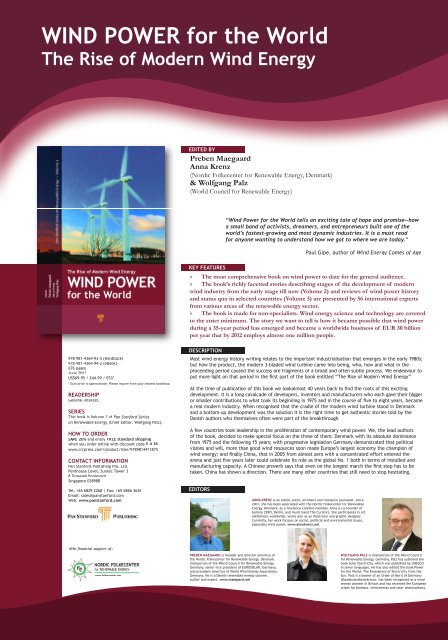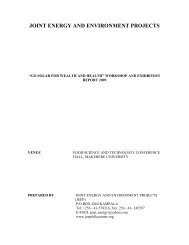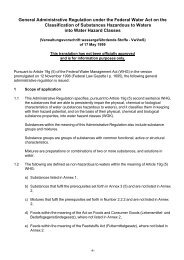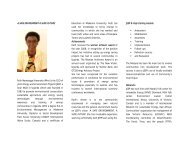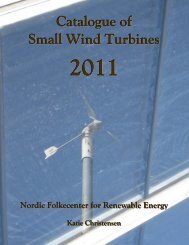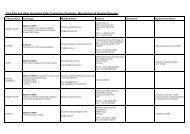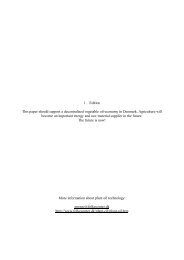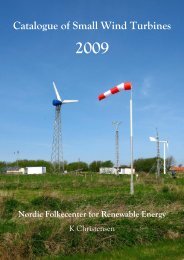Wind Power for the World - Nordic Folkecenter for Renewable Energy
Wind Power for the World - Nordic Folkecenter for Renewable Energy
Wind Power for the World - Nordic Folkecenter for Renewable Energy
Create successful ePaper yourself
Turn your PDF publications into a flip-book with our unique Google optimized e-Paper software.
wind wind poweR poweR R <strong>for</strong> <strong>for</strong> <strong>the</strong> <strong>the</strong><br />
world<br />
<strong>the</strong> <strong>the</strong> Rise Rise of of modern wind energy<br />
978-981-4364-93-5 (Hardback)<br />
978-981-4364-94-2 (eBook)<br />
676 pages<br />
June 2013<br />
US$69.95 / £44.99 / €53*<br />
* Euro price is approximate. Please inquire from your nearest bookshop.<br />
ReadeRship<br />
General interest.<br />
seRies<br />
This book is Volume 2 of Pan Stan<strong>for</strong>d Series<br />
on <strong>Renewable</strong> <strong>Energy</strong> (Chief Editor: Wolfgang Palz).<br />
how to oRdeR<br />
saV sa e 20% and enjoy FRee standard shipping<br />
when you order online with discount code dJL38<br />
www.crcpress.com/product/isbn/9789814411875<br />
ContaCt inFoRmation<br />
Pan Stan<strong>for</strong>d Publishing Pte. Ltd.<br />
Penthouse Level, Suntec Tower 3<br />
8 Temasek Boulevard<br />
Singapore 038988<br />
Tel: +65 6829 2268 | Fax: +65 6866 3636<br />
Email: sales@panstan<strong>for</strong>d.com<br />
Web: www.panstan<strong>for</strong>d.com<br />
With financial support of:<br />
www.folkecenter.net<br />
edited by<br />
Preben Maegaard<br />
Anna Krenz<br />
(<strong>Nordic</strong> <strong>Folkecenter</strong> <strong>for</strong> <strong>Renewable</strong> <strong>Energy</strong>, Denmark)<br />
& Wolfgang Palz<br />
(<strong>World</strong> Council <strong>for</strong> <strong>Renewable</strong> <strong>Energy</strong>)<br />
Key FeatuRes<br />
“<strong>Wind</strong> <strong>Power</strong> <strong>for</strong> <strong>the</strong> <strong>World</strong> tells an exciting tale of hope and promise—how<br />
a small band of activists, dreamers, and entrepreneurs built one of <strong>the</strong><br />
world’s fastest-growing and most dynamic industries. It is a must read<br />
<strong>for</strong> anyone wanting to understand how we got to where we are today.”<br />
Paul Gipe, author of <strong>Wind</strong> <strong>Energy</strong> Comes of Age<br />
» The most comprehensive book on wind power to date <strong>for</strong> <strong>the</strong> general audience.<br />
» The book’s richly facetted stories describing stages of <strong>the</strong> development of modern<br />
wind industry from <strong>the</strong> early stage till now (Volume 2) and reviews of wind power history<br />
and status quo in selected countries (Volume 3) are presented by 56 international experts<br />
from various areas of <strong>the</strong> renewable energy sector.<br />
» The book is made <strong>for</strong> non-specialists. <strong>Wind</strong> energy science and technology are covered<br />
to <strong>the</strong> strict minimum. The story we want to tell is how it became possible that wind power<br />
during a 35-year period has emerged and became a worldwide business of EUR 30 billion<br />
per year that by 2012 employs almost one million people.<br />
desCRiption<br />
Most wind energy history writing relates to <strong>the</strong> important industrialisation that emerges in <strong>the</strong> early 1980s;<br />
but how <strong>the</strong> product, <strong>the</strong> modern 3-bladed wind turbine came into being, who, how and what in <strong>the</strong><br />
proceeding period caused <strong>the</strong> success are fragments of a broad and often subtle process. We endeavour to<br />
put more light on that period in <strong>the</strong> first part of <strong>the</strong> book entitled “The Rise of Modern <strong>Wind</strong> <strong>Energy</strong>”.<br />
At <strong>the</strong> time of publication of this book we lookalmost 40 years back to find <strong>the</strong> roots of this exciting<br />
development. It is a long cavalcade of developers, inventors and manufacturers who each gave <strong>the</strong>ir bigger<br />
or smaller contributions to what took its beginning in 1975 and in <strong>the</strong> course of five to eight years, became<br />
a real modern industry. When recognised that <strong>the</strong> cradle of <strong>the</strong> modern wind turbine stood in Denmark<br />
and a bottom-up development was <strong>the</strong> solution it is <strong>the</strong> right time to get au<strong>the</strong>ntic stories told by <strong>the</strong><br />
Danish authors who <strong>the</strong>mselves often were part of <strong>the</strong> breakthrough.<br />
A few countries took leadership in <strong>the</strong> proliferation of contemporary wind power. We, <strong>the</strong> lead authors<br />
of <strong>the</strong> book, decided to make special focus on <strong>the</strong> three of <strong>the</strong>m: Denmark with its absolute dominance<br />
from 1975 and <strong>the</strong> following 15 years; with progressive legislation Germany demonstrated that political<br />
visions and will, more than good wind resources soon made Europe’s largest economy <strong>the</strong> champion of<br />
wind energy; and finally China, that in 2005 from almost zero with a concentrated ef<strong>for</strong>t entered <strong>the</strong><br />
arena and just five years later could celebrate its role as <strong>the</strong> global No. 1 both in terms of installed and<br />
manufacturing capacity. A Chinese proverb says that even on <strong>the</strong> longest march <strong>the</strong> first step has to be<br />
taken. China has shown a direction. There are many o<strong>the</strong>r countries that still need to stop hesitating.<br />
editoRs<br />
pReben maegaaRd is founder and director emeritus of<br />
<strong>the</strong> <strong>Nordic</strong> <strong>Folkecenter</strong> <strong>for</strong> <strong>Renewable</strong> <strong>Energy</strong>, Denmark,<br />
chairperson of <strong>the</strong> <strong>World</strong> Council <strong>for</strong> <strong>Renewable</strong> <strong>Energy</strong>,<br />
Germany, senior vice president of EUROSOLAR, Germany,<br />
and president emeritus of <strong>World</strong> <strong>Wind</strong> <strong>Energy</strong> Association,<br />
Germany. He is a Danish renewable energy pioneer,<br />
author and expert. www.maegaard.net<br />
anna KRenz is an editor, artist, architect and freelance journalist. Since<br />
2001, she has been associated with <strong>the</strong> <strong>Nordic</strong> <strong>Folkecenter</strong> <strong>for</strong> <strong>Renewable</strong><br />
<strong>Energy</strong>, Denmark, as a freelance creative member. Anna is co-founder of<br />
Gallery ZERO, Berlin, and music band The Curators. She participates in art<br />
exhibitions worldwide, works also as an illustrator and graphic designer.<br />
Currently, her work focuses on social, political and environmental issues,<br />
especially wind power. www.annakrenz.net<br />
woLFgang paLz is chairperson of <strong>the</strong> <strong>World</strong> Council<br />
<strong>for</strong> <strong>Renewable</strong> <strong>Energy</strong>, Germany. Palz has authored <strong>the</strong><br />
book Solar Electricity, which was published by UNESCO<br />
in seven languages. He has also edited <strong>the</strong> book <strong>Power</strong><br />
<strong>for</strong> <strong>the</strong> <strong>World</strong>: The Emergence of Electricity from <strong>the</strong><br />
Sun. Palz is a bearer of an Order of Merit of Germany<br />
(Bundesverdienstkreuz), has been recognised as a wind<br />
energy pioneer in Britain and has received <strong>the</strong> European<br />
prizes <strong>for</strong> biomass, wind energy and solar photovoltaics.
<strong>Wind</strong> <strong>Wind</strong> PoWer PoWer er <strong>for</strong> <strong>for</strong> <strong>the</strong> <strong>the</strong> <strong>World</strong><br />
<strong>World</strong><br />
The The rise of Modern <strong>Wind</strong> energy<br />
a roadmap in Pursuit of <strong>the</strong> Legend<br />
of Modern <strong>Wind</strong> <strong>Power</strong><br />
With respect to every ef<strong>for</strong>t made to make wind energy a unique success,<br />
a search <strong>for</strong> <strong>the</strong> roots of <strong>the</strong> story points especially to <strong>the</strong> role of denMark.<br />
Here, <strong>the</strong> first commercial, reliable and af<strong>for</strong>dable wind turbines appeared as<br />
people’s response to an oil crisis that had caused severe unemployment and<br />
financial problems <strong>for</strong> this small north European country’s five million people.<br />
Denmark relied 100% on imported oil <strong>for</strong> heating, electricity and mobility.<br />
A paradigm shift within <strong>the</strong> supply of energy was absolutely necessary.<br />
Fortunately, a large number of people were ready to spend <strong>the</strong>ir savings to<br />
purchase a wind turbine. At <strong>the</strong> same time many o<strong>the</strong>r people had visions and<br />
passion to design and manufacture <strong>the</strong> perfect windmill, that within a five-year<br />
period, through <strong>the</strong> trial-and-error method and countless experiments, resulted<br />
in what proved to become <strong>the</strong> contemporary wind turbine concept and <strong>the</strong> basis<br />
of large-scale, worldwide industrialisation. When we decided to bring up this<br />
book on wind power, we looked 40 years back to find <strong>the</strong> roots of this exciting<br />
development and recognised that <strong>the</strong> cradle of <strong>the</strong> modern wind turbine stood<br />
in Denmark and a bottom-up development was <strong>the</strong> solution. We realised that<br />
this is <strong>the</strong> right time to get au<strong>the</strong>ntic stories from <strong>the</strong> Danish authors, who<br />
<strong>the</strong>mselves were often part of this breakthrough, and have first-hand reports<br />
to bring <strong>for</strong>th <strong>the</strong> most important events, technologies, successes as well as<br />
mistakes. It may soon be too late. The pioneers had to acquire fundamental<br />
knowledge on aerodynamics, technology and controls; make mistakes; learn<br />
from experience and often ruin <strong>the</strong>ir own economy—but every time someone<br />
would take over and experiences would not go wasted.<br />
The development of wind power was based on whatever worked best, while <strong>the</strong><br />
negative results were left behind when <strong>the</strong>y did not turn out to be any good.<br />
Thus, it is a long cavalcade of developers, inventors and manufacturers who<br />
each gave <strong>the</strong>ir big or small contributions to what took its beginning in 1975<br />
and, in <strong>the</strong> course of five to eight years, became a real modern industry. industry<br />
In that period <strong>the</strong> “Danish Concept” was defined; reliable and af<strong>for</strong>dable wind<br />
turbines became available. The first uncertain steps into <strong>the</strong> Fourth Revolution—<br />
<strong>the</strong> transition to renewable energies— were taken in Denmark in <strong>the</strong> same period<br />
when <strong>the</strong> heroes of <strong>the</strong> Third Revolution, people like Steve Jobs and Bill Gates,<br />
fumbled with and engineered <strong>the</strong>ir equipment and software <strong>for</strong> some of <strong>the</strong> first<br />
commercially successful personal computers, <strong>the</strong> backbone of <strong>the</strong> in<strong>for</strong>mation<br />
society that later reached out to every corner of <strong>the</strong> world. However, <strong>the</strong>re is<br />
a decisive difference. Bill Gates <strong>for</strong> his part kept <strong>the</strong> copyright of his operating<br />
system <strong>for</strong> himself. He believed that o<strong>the</strong>r vendors would clone it. The Danish<br />
wind energy pioneers in contrast had grown up in a totally different tradition:<br />
open source.<br />
When Denmark in 1895 got its first patent law, technologies and processes <strong>for</strong><br />
use in agriculture were explicitly excluded from copyrights and patents. This<br />
principle of openness and sharing of knowledge by <strong>the</strong> Danish wind energy<br />
pioneers was maintained as extremely essential <strong>for</strong> <strong>the</strong> innovative culture.<br />
There was no fear of ideas being cloned and concrete solutions were never<br />
protetcted by copyrights or patents. The principle learned from Poul la Cour,<br />
<strong>the</strong> Danish wind energy pioneer 100 years earlier, was as follows: Patents, if any,<br />
should belong to <strong>the</strong> Danish people. For decades, <strong>the</strong> universities had severely<br />
neglected research and capacity building within renewable energy, not realising<br />
that <strong>the</strong> fossil and atomic era would some day come to an end. There<strong>for</strong>e, <strong>the</strong><br />
Danish wind energy pioneers wanted <strong>the</strong> scarce technology know-how to be freely<br />
available to anyone who wanted to use and clone it. They believed that energy<br />
from <strong>the</strong> wind and <strong>the</strong> sun belonged to us all, and <strong>the</strong>re<strong>for</strong>e, <strong>the</strong> knowledge to<br />
harvest renewable energies should be part of <strong>the</strong> heritage of mankind.<br />
During <strong>the</strong> 1980s, wind industry in <strong>the</strong> UniTed STa Ta TaT aTeS, <strong>the</strong> biggest economy of<br />
<strong>the</strong> world, passed through a rapid rise and fall with later ups and downs, while <strong>the</strong><br />
young GerM Ger an industry attached to <strong>the</strong> Danish supply chain with its specialised,<br />
independent suppliers of blades, control systems, etc. Emerging manufacturers<br />
made robust wind turbines long be<strong>for</strong>e <strong>the</strong> first German renewable energy law<br />
opened <strong>the</strong> market <strong>for</strong> large-scale investments and regular industrialisation.<br />
<strong>Wind</strong> power soon gained significant shares at <strong>the</strong> cost of conventional power<br />
sector that was dominated by big and politically influential power oligopolies. In<br />
1995, SPain Pain P introduced <strong>the</strong> German version of <strong>the</strong> feed-in tariffs (FITs)—<strong>the</strong> key<br />
to rapid and decentralised renewable energy development. The country did not<br />
rely on imported wind turbines and got its own advanced manufacturing sector<br />
with brands that became well known in <strong>the</strong> international market. Ten years<br />
later in 2005, China, in search <strong>for</strong> additional electricity production capacity<br />
and with an eye <strong>for</strong> a new industrial growth sector, also joined <strong>the</strong> wind energy<br />
frontrunners. By opening <strong>the</strong> door <strong>for</strong> <strong>the</strong> best available technology, <strong>the</strong> biggest<br />
nation in <strong>the</strong> world diligently avoided mistakes that delayed <strong>the</strong> industrialisation<br />
in most o<strong>the</strong>r countries. Soon China got its own complete supply chain and more<br />
than 50 MW–size suppliers of wind turbines. After a five-year period of concerted<br />
ef<strong>for</strong>t, a completely new industry emerged that made China <strong>the</strong> absolute leader in<br />
<strong>the</strong> wind power sector, both in terms of manufacturing and installed capacity.<br />
With <strong>the</strong> rediscovery of <strong>the</strong> asynchronous generator,<br />
this book presents various sides of <strong>the</strong> origin of <strong>the</strong><br />
contemporary wind turbine design and acknowledge<br />
people who made crucial conceptual and technological<br />
contributions in <strong>the</strong> wind power revolution, especially<br />
Johannes Juul and Christian Riisager. In 1976, Christian<br />
Riisager was <strong>the</strong> first to commercialise a small wind<br />
turbine using J. Juul’s design principles from <strong>the</strong> 1950s<br />
and like o<strong>the</strong>r manufactures could sell it to Danish<br />
people willing to spend <strong>the</strong>ir money on alternatives to<br />
<strong>the</strong> imported oil.<br />
It was not <strong>the</strong> hybrid blade technology of Juul and<br />
Riisager, however, that lead <strong>the</strong> way to <strong>the</strong> development<br />
of <strong>the</strong> so-called daniSh ConCePT, but <strong>the</strong> 2 MW Tvind<br />
windmill, designed and built by a group of amateurs and<br />
idealists from <strong>the</strong> Tvind School. In 1976, Tvind transferred<br />
Professor Ulrich Hütter’s advanced blade technology<br />
from <strong>the</strong> Technical University of Stuttgart to Denmark<br />
and made it available <strong>for</strong> <strong>the</strong> general public. The newly<br />
founded Økær Vind Energi brought to <strong>the</strong> market Tvind’s<br />
downscaled 4.5 m fibreglass blade, <strong>the</strong> basis of <strong>the</strong><br />
emerging component wind turbine.<br />
Modern <strong>Wind</strong> <strong>Power</strong> Timeline<br />
Soon after, North-western Jutland Institute <strong>for</strong> <strong>Renewable</strong><br />
<strong>Energy</strong> (NIVE), divided up a wind turbine’s structure into<br />
four basic elements that were manageable items within<br />
<strong>the</strong> existing specialised industries. Specifications were<br />
defined <strong>for</strong> modular wind turbine components (blades,<br />
controls) which lead to <strong>the</strong> emerging supply chain that<br />
enabled <strong>the</strong> Herborg blacksmith, members of <strong>the</strong> Danish<br />
Blacksmiths’ Association and o<strong>the</strong>r small enterprises to<br />
manufacture and assemble reliable and af<strong>for</strong>dable 15 kW<br />
to 22 kW wind turbines.<br />
This book describes how <strong>the</strong> combination of J. Juul’s<br />
principles (heavy, up-wind, 3-bladed, asynchronous<br />
generator, stall-regulated) with Ulrich Hütter’s/Tvind’s<br />
advanced blade fibreglass design and root assembly<br />
resulted in <strong>the</strong> winning wind turbine concept, called <strong>the</strong><br />
daniSh ConCePT.<br />
Preben Maegaard<br />
Lead author<br />
<strong>Folkecenter</strong> <strong>for</strong> <strong>Renewable</strong> <strong>Energy</strong>, Denmark<br />
Summer 2013<br />
The development of Modern <strong>Wind</strong> turbine
<strong>Wind</strong> PoWer <strong>for</strong> <strong>the</strong> <strong>World</strong><br />
The rise of Modern <strong>Wind</strong> energy<br />
Table of ConTenTS<br />
Chapters<br />
Preface<br />
Acknowledgements<br />
Introduction<br />
The <strong>Wind</strong> <strong>Power</strong> Story<br />
Forty Years of <strong>Wind</strong> <strong>Energy</strong> Development<br />
History of Danish <strong>Wind</strong> <strong>Power</strong><br />
The aerodynamical research on windmill sails by Poul la Cour, 1896-1900<br />
Networks of <strong>Wind</strong> <strong>Energy</strong> Enthusiasts and The Development of The “Danish Concept“<br />
Danish Pioneering of Modern <strong>Wind</strong> <strong>Power</strong><br />
From <strong>Energy</strong> Crisis to Industrial Adventure – a Chronicle<br />
Økær Vind Energi—Standard Blades <strong>for</strong> <strong>the</strong> Early <strong>Wind</strong> Industry<br />
From Herborg Blacksmith to Vestas<br />
From Danregn to Bonus<br />
Vind-Syssel 1985-1990<br />
The Story of Dencon<br />
Water Brake <strong>Wind</strong>mills<br />
Cooperative <strong>Energy</strong> Movement in Copenhagen<br />
Danish Small <strong>Wind</strong> <strong>Power</strong><br />
Consigned to Oblivion<br />
Hütter’s Heritage – The Stuttgart School<br />
Overview of German <strong>Wind</strong> Industry Roots<br />
Direct Drive <strong>Wind</strong> Turbines<br />
How early 80’s Micro- and <strong>Power</strong>-Electronics Innovation in Germany Revolutionised<br />
<strong>Wind</strong> <strong>Energy</strong> Systems<br />
How <strong>the</strong> Electricity Feed-In Law (Stromeinspeisungsgesetz) Came to Be Passed by <strong>the</strong> German<br />
Parliament, Enabling <strong>Renewable</strong> Energies to Establish Their Position in <strong>the</strong> Market<br />
<strong>Wind</strong>, Women, Art, Acceptance<br />
Cali<strong>for</strong>nia – <strong>Wind</strong> Farms Retrospective<br />
Emergence of <strong>Wind</strong> <strong>Energy</strong>: The University of Massachusetts<br />
An American Personal Perspective<br />
Residential <strong>Wind</strong> by Way of Illustration<br />
<strong>Wind</strong> <strong>Power</strong> in China: Chasing <strong>the</strong> Dream that Creates Value<br />
Rising <strong>Wind</strong> <strong>Power</strong> Industry of XEMC<br />
CoMinG Soon...<br />
author(s)<br />
Wolfgang Palz<br />
Preben Maegaard, anna nna Krenz<br />
Preben Maegaard<br />
ross oss Jackson<br />
H.J.M. (Jos) beurskens<br />
benny enny Christensen<br />
Povl-otto nissen<br />
Ka<strong>the</strong>rine dykes ykes<br />
niels iels i. . Meyer<br />
Preben Maegaard<br />
erik Grove-nielsen<br />
Henrik Stiesdal<br />
egon Kristensen<br />
flemming lemming Østergaard<br />
bent Gregersen<br />
Jørgen Krogsgaard<br />
Jens H. larsen<br />
Jane Kruse<br />
Preben Maegaard<br />
bernward ernward Janzing, Jan oelker elker<br />
arne Jaeger<br />
friderich riderich Klinger<br />
Jürgen Sachau<br />
Ulrich Jochimsen<br />
brigitte Schmidt<br />
arne rne Jaeger<br />
James Manwell<br />
Steven b. . Smiley & Susan J. Kopka<br />
igor avkshtol a<br />
Qin Haiyan<br />
Zhou Jianxiong<br />
Pan Stan<strong>for</strong>d Series on <strong>Renewable</strong> <strong>Energy</strong> – Volume 3<br />
<strong>Wind</strong> PoWer <strong>for</strong> <strong>the</strong> <strong>World</strong><br />
international reviews and developments<br />
aUTHorS:<br />
Jean-Louis Bal, France<br />
Khalid Benhamou, Morocco<br />
John Chadjivassiliadis, Greece<br />
Victor V. Elistratov, Russia<br />
Jose Etcheverry, Canada<br />
Everaldo Feitosa, Brazil<br />
Hans-Josef Fell, Germany<br />
Conrado Moreno Figueredo, Cuba<br />
Stefan Gsänger, Germany<br />
Gu Weidong, China<br />
He Dexin, China<br />
Wolfgang Hein, Austria<br />
Jami Hossain, India<br />
Frede Hvelplund, Denmark<br />
Arne Jaeger, Germany<br />
Marc Jedliczka, France<br />
Anil Kane, India<br />
Freidrich Klinger, Germany<br />
Andrei Konechenkov, Ukraine<br />
Arturo Kunstmann, Chile<br />
Preben Maegaard, Denmark<br />
Galal Osman, Egypt<br />
Wolfgang Palz, Belgium<br />
Krzysztof Prasalek, Poland<br />
Alina Prokopenko, Russia<br />
Josep P. Puig, Spain<br />
Galyna Shmidt, Ukraine<br />
Erico Spinadel, Argentina<br />
Volker Thomsen, Canada<br />
Izumi Ushiyama, Japan<br />
Tanay Sidki Uyar, Turkey<br />
Stephan Volkwein, Switzerland<br />
In <strong>the</strong> second part of <strong>the</strong> book “International Reviews and Develoments”, we collected reports<br />
and overviews of wind power status and history in various countries. The uphill struggle; wind<br />
energy strategies and policies that paved <strong>the</strong> way; <strong>the</strong> creative persons in politics, agencies,<br />
institutes, <strong>the</strong> industry; <strong>the</strong> world societies at large, and how <strong>the</strong> challenges found a solution<br />
in different countries at <strong>the</strong> end are <strong>the</strong> main issues.<br />
978-981-4411-89-9 (Hardback) | 978-981-4411-90-5 (eBook)<br />
~600 pages | October 2013 | US$69.95 / £44.99 / €53*<br />
* Euro price is approximate. Please inquire from your nearest bookshop.


